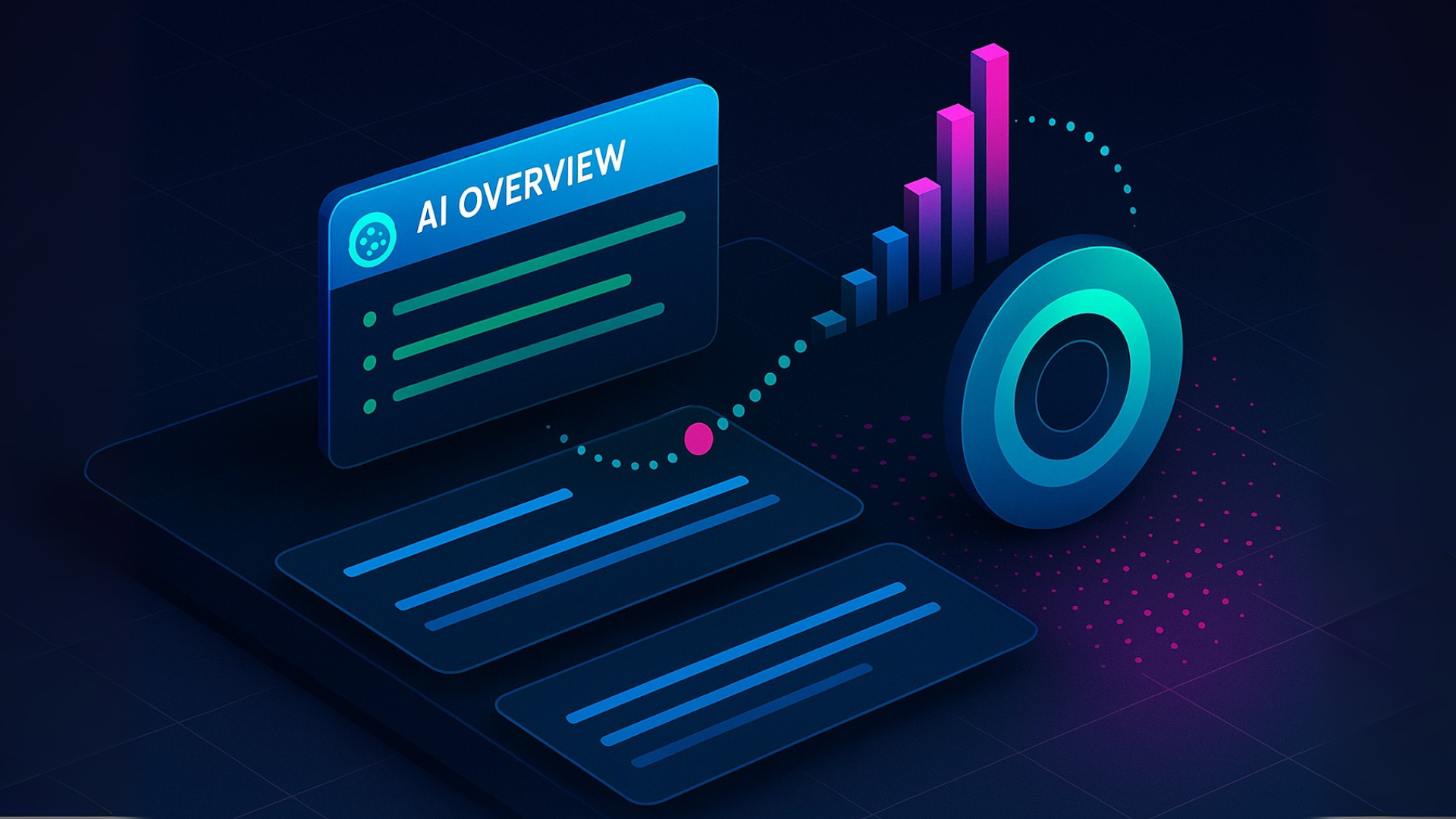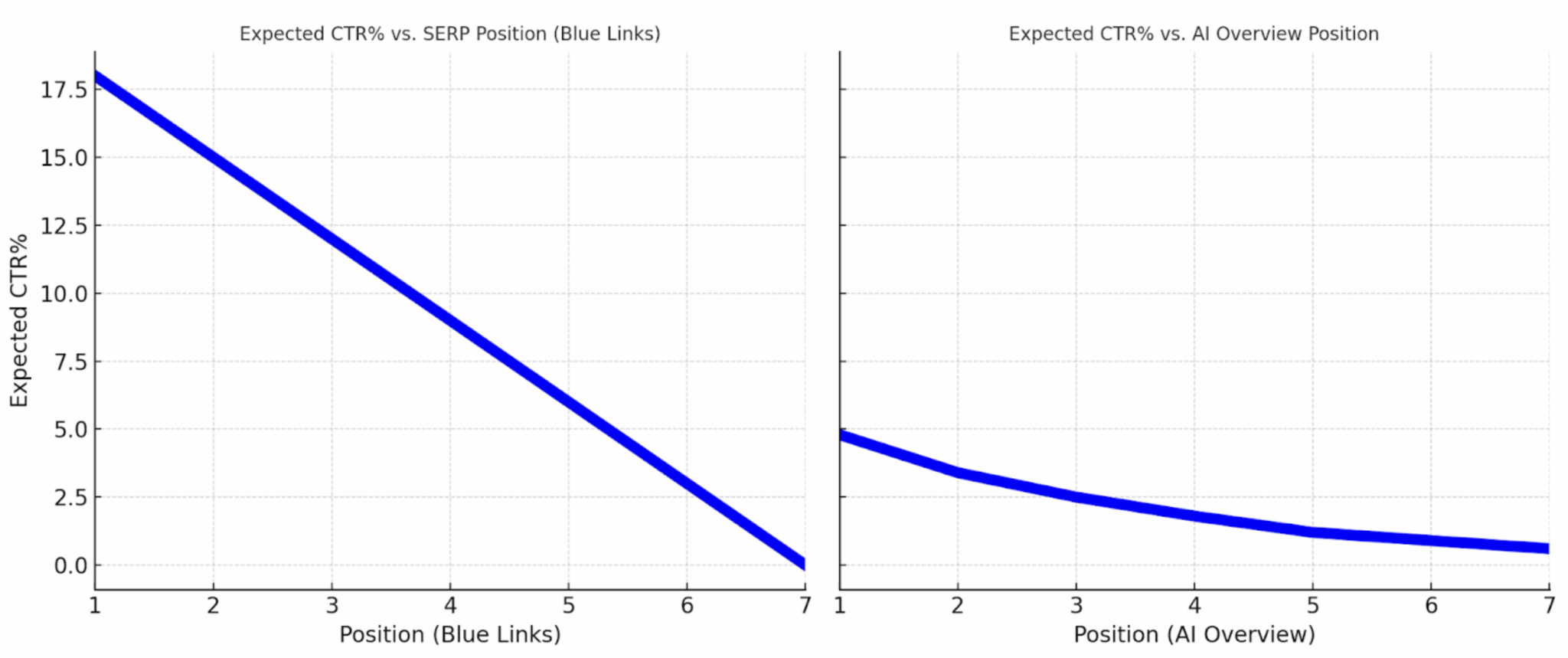AI Overview citations: Why they don’t drive clicks and what to do

Visibility in Google’s AI Overviews doesn’t equal traffic.
In my research from the first half of this year, AI Overview citations consistently underperformed – even compared to traditional blue links near the bottom of the SERP.
An AI Overview citation can still help with authority, brand recall, positioning, and maybe even long-term LLM training.
But for short-term clicks? The data paints a sobering picture.
How AI Overviews vs. blue links compare: What the data shows
Are AI Overview citations actually gathering clicks? Or are they just pushing the real click-producers further down the page?
That question led me to look at the performance of classic blue links and AI Overviews across a dozen different industries.
Inside the research
This analysis draws on more than 20,000 ranking queries across industries, including:
- Automotive repair.
- Ecommerce.
- Education.
- Fitness.
- Healthcare.
- Manufacturing.
- SaaS.
From that pool, a focused case study examined 200+ unique SERPs from February to April 2025 where AI Overviews appeared.
Using Google Search Console and Semrush, the study tracked:
- The position of each domain inside the Overview.
- The same domain’s position in the traditional blue links.
- CTR, impressions, and clicks.
To keep the analysis clean, I only counted the first appearance of a link in an AI Overview to avoid inflating performance with duplicates.
What the study found
- Ranking first in an AI Overview delivers roughly Position 6 clicks: Far from the golden ticket many assume.
- AI Overview CTR curves fall off a cliff – fast: By Position 5, most citations might as well be on the 10th page of Google’s search results.
- The Top 3 blue links still perform best: The strongest AI Overview slot doesn’t match the Top 3 organic SERP results. Blue links still dominate where it matters: driving real, high-intent traffic.

Dig deeper: Will Google’s AI Overviews kill the click?
So, why aren’t AI Overviews driving clicks?
The fact that the addition of AI Overview citations to SERPs is hurting clicks isn’t exactly breaking news.
Since AI Overviews have been implemented, they have been documented to hurt click-through rates across the SERP, particularly on informational queries.
But this shows that the answer isn’t as simple as shooting for AI Overview placements, assuming the new “top” overall SERP placement will compensate for lost clicks.
The problem is even stickier for AI Overviews.
Part of the issue is that user intent is becoming (even more) satisfied on-screen.
It’s the same, classic zero-click search problem that’s been ongoing since People also ask placements, with Google now synthesizing these answers for users.
But AI Overviews have even greater issues that minimize their value to content creators due to their unique placement, structure, and organization.
AI Overview brand mentions lack context
In a blue link, the brand is both a doorway and a marquee.
After all, a traditional blue link has an optimized title and an attention-grabbing meta description to attract that all-valuable click.
But in AI Overviews, brands are given a small, bland citation, with only a fraction of the meta description available. It’s basically a mousehole.
Position inflation
Being “first” in an Overview doesn’t carry the same weight as “first” in organic results.
The top of SERPs is overly busy with AI Overviews, paid ads, site links, map packs, and other features.
Data shows that search users agree: many searchers are scrolling down, looking for an escape from the clutter.
With AI Overviews, engagement swiftly drops off a cliff
Users scan several blue links, but attention collapses in AI Overviews. Citations are small, hard to scroll, and visually unappealing.
Other searchers clearly agree. The CTR curve shows a steep decay, so that by AI Overview citation 4 or 5, your link basically doesn’t exist.
What should SEOs do about it?
First, we need to reframe the way we present our data, our goals, and maybe even our service.
- Visibility ≠ traffic: If you’re reporting clicks to leadership, AI Overview citations will not save your dashboards. That’s why some SEOs are making the move to attribute other channel traffic to their efforts. (More on that, later.)
- SERP authority ≠ ROI: Yes, being cited in an AI Overview lends credibility and visibility. It may even eventually contribute to a click, down the line of a user’s search experience. But that credibility is more abstract than ever and more challenging to track.
- The battle for top blue link positions is far from over: You still need to fight for top blue link positions. AI Overviews haven’t “leveled the field” against any established top 3 ranking competitor content. They’ve just added another, weaker layer to the SERP.
Get the newsletter search marketers rely on.
See terms.
Now, here’s where things actually get actionable.
1. Optimize for the overview, but don’t overvalue
AI Overview citations do matter. A top ranking here can match a decent organic result, but not a Top 3 slot.
I’ve found the most success in ranking for AI Overviews by treating them similarly to People also ask snippets, by focusing on “answer capsules.”
Here’s what’s worked for me.
- Start by identifying high-volume FAQs
- Look for high-volume terms, using tools like Semrush’s Keyword Overview, and identify queries already displaying AI Overviews.
- Similar to traditional blue links, I’ve found keyword difficulty does matter for AI Overviews, but a highly difficult score is less of a hindrance.
- Low authority or new domains often still have a shot to rank highly in AI Overviews against established competitors.
- Place tight, authoritative answer capsules after H2s or H3s
- Treat an answer like a highly optimized meta description.
- Keep a summarized answer, or “answer capsule,” to less than 200 characters.
- A quick, confident, and summarized answer that can be easily cited is a must.
- You’ll add more information below, fleshing out your answer to provide more in-depth information to users on your site.
- Don’t externally link in your answer capsule
- Don’t communicate to search engines that another resource is a better source on the topic.
- Never externally link in an area of copy you believe is a target for an AI Overview.
Other SEO best practices also apply.
- Use structured markup where it makes sense.
- Anticipate natural language queries. Read content like a user and answer their questions, even if they’re not high-volume keywords.
- Make content that makes sense for people, since search engines and LLMs care most about them.
2. Double down on Page 1 blue links
Top 3 rankings are still the primary click drivers.
In-depth content, written for users who experience it on-page, is still the best strategy for dominating the top of Google’s blue links.
Search might have changed, but you should continue to prioritize optimizing for:
- Content depth: More informed and topically thorough posts produce longer engaged sessions, lower bounce rates, and drive more in-site traffic. That hasn’t changed.
- Link authority: Backlinks still matter, for both AI Overviews and traditional blue links.
- Technical health: Whether it’s blue links, AI Overviews, or other SERP features, your site needs to perform well. Keep an eye on those Core Web Vitals.
Dig deeper: The search visibility framework: Dominating every corner of the SERP in 2026
3. Consider tracking ‘assisted conversions’
Search has changed. Why wouldn’t we change the way we track how users search?
When framing AI Overviews to stakeholders, it can be helpful to understand AI Overview mentions as an upper-funnel assist.
They might not deliver the click now, but they prime users for later recognition.
But don’t go too far.
I see some SEOs are making the move to attribute other channel traffic to their efforts.
It makes sense, since visibility one day can lead to a variety of different channel traffic on another.
After all, commercials and billboards work for a reason.
Be skeptical of claims that AI Overview visibility drives large spikes in direct traffic.
While it would be lovely to claim credit for direct as an SEO, it seems odd to expect that organic users are really typing in specific URLs without a referral link or Google search.
That said, I do think it’s reasonable to assume AI Overviews drive some gains to branded organic traffic.
Increasingly, parsing out branded and non-branded traffic – a long-standing best practice for reporting – may not be painting as clear a picture as it used to.
In other words, we need to think hard about what our domain’s user journeys really look like. We also need to present them to decision-makers in a way that makes sense, not just looks good for SEOs.
4. Track CTR realistically
We have to stop benchmarking against outdated CTR expectations.
For years, I’ve seen numbers as high as 40% expected CTR for a Position 1 overall ranking, and this really isn’t based on anything accurate anymore.
Run a search, and you’ll find a number of these inflated estimates on SERPs (and now, AI Overviews!).
It’s time we just throw these numbers out the window. Back up these estimates with real data.
Educate stakeholders, so they don’t chase the wrong KPIs – and expect them from you.
Dig deeper: Want to beat AI Overviews? Produce unmistakably human content
Visibility isn’t a click, but it is valuable
AI Overviews are flashy and feel like a win, but they’re visibility – not a traffic engine.
Measuring them as such misleads stakeholders.
For SEOs and digital marketers, the right playbook is clear:
- Keep authority building through links, technical health, content depth, and other traditional SEO best practices.
- Chase and defend top blue link positions. They’re moving the needle most.
- Treat AI Overview citations as upper-funnel brand moments, not the centerpiece of reporting.
In other words: don’t mistake this new gold star sticker for revenue.
Celebrate the visibility, but keep KPIs anchored where the most clicks – and business impact – actually come from.







Recent Comments